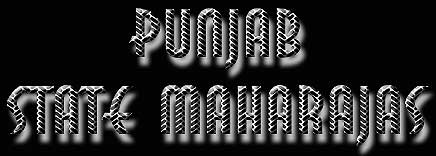

Tiloka the ancestor of both Nabha and Jind was a son of Phool. Both these states were memebrs of the Phulkian misal. Tiloka had two sons Gurditta and Sukchain, the former was the ancestor of the Nabha family and the latter of the Jind family.Gurditta died in 1752 and was succeeded by his grandson, Hameer Singh. Raja Hameer Singh founded the state of Nabha in 1755. He was succeeded by his son Raja Jaswant Singh in 1790.
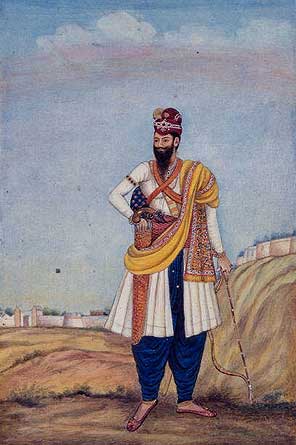
Jaswant Singh (above) was an ardent supporter of Maharajah Ranjit Singh (Lion of Punjab).
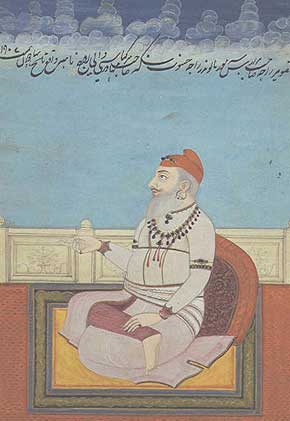
Maharaja Jaswant Singh 1783 -1840
In 1880, the titles of Maharajah
and Raja-i-Rajgan was granted to the ruler of Nabha.
Nabha was absorbed into
the Indian union on May the 5th, 1948. The Maharajah was sanctioned an annual
allowance of 4 lakh and 10 thousand rupees a year.
Maharajah Pratap Singh sued
the British crown jewellers, Gerrard when they failed to return jewels that included
: 175 diamonds, 203 runies, 11 pearls, 256 emeralds and 19 suites of diamond,
ruby, emerald and pearl necklaces, earings and bracelets.
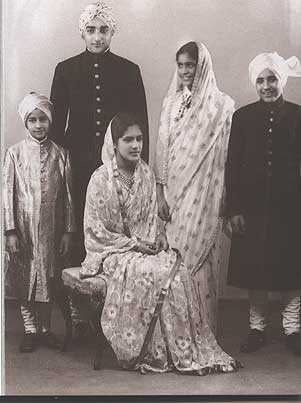
H.H.Maharaja Sir Partap Singh, Malvendra Bahadur of Nabha (1919-1995) and members of his family - photo 31 October 1936 (photo courtesy The Lafayette studio-Russel Harris)
The Raja of Nabha
The Chief
of Nabha is descendent from the same stock as the Maharajas of Patiala and Jind
(hence the name Phulkian States from the common ancestor named Phul), but like
the latter belongs to the elder branch of the family. Nabha State was part of
the the treaty of 1809 for the protection of the Kingdom from the Maharaja of
Lahore, Ranjit Singh (the lion of Punjab). Maharaja Jaswant Singh of Nabha died
in 1840 and was succeeded by his son Devinder Singh. In 1845, during the Sikh
war, Devinder Singh withheld supplies from the British, and as punishment was
deposed in 1846 (died in confinement in 1865). Devinder's son, Bharpur Singh,
had been installed as the Maharaja in 1847.
Bharpur Singh died in 1863, leaving
no heir. The Maharajas of Patiala and Jind were called upon to select a new heir
to the throne. They chose the younger brother of Bharpur Singh, Bhagwan Singh,
who was installed in 1864 but later died in 1871 without heirs. Again the rulers
of Patiala and Jind were summoned to select another relative as heir, and they
selected a collateral relative, Hira Singh. During Sir Hira Singh's time, the
Kingdom saw its greatest recognition and growth. A Rajput Nobles of the State,
Khan Bahadar Sardar Bakhshi Wali Mohammed Khan and his ancestors, were recognized
as one of the few leading personalities of these princely Kingdoms. The famous
Bakhshi family had rendered service at all three states of Jind, Patiala, and
Nabha.
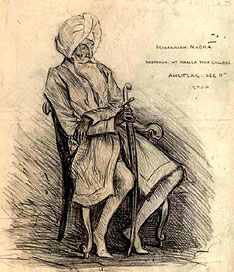
Maharaja Hira Singh of Nabha, Sketched at Khalsa Sikh College, Amritsar, December 11th (1903?), Sketch by G.P. Jacomb-Hood (sketch, courtesy of Ralph Lake)
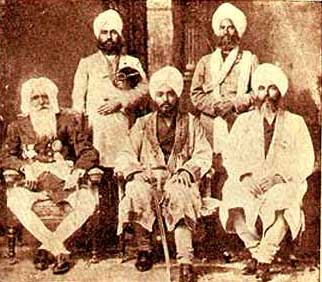
Maharaja
Hira Singh, Tika Ripudamman Singh and renowned Sikh Author Bhai Kahn Singh Nabha
- Standing: Nihal Singh & Munshi Faiz Bakht
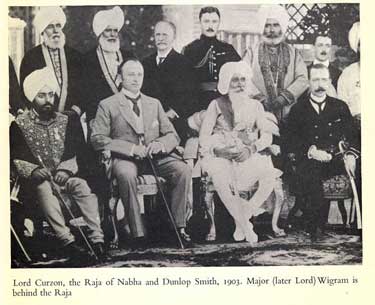
RIPUDAMAN SINGH, MAHARAJA (1883-1942), ruler of the princely state of Nabha from 1912 to 1923, was born at Nabha on 22 Phagun 1939 Bk/4 March 1883, the only son of Maharaja Hira Singh (1843-1911) and Maharani Jasmer Kaur. His father having resisted British advice to send his heir to one of the newly established Chiefs' Colleges modelled on English public schools, Tikka (heir apparent) Ripudaman Singh was educated by private tutors including Lala Bishan Das and Sardar (Bhal) Kahn Singh, celebrated Sikh scholar and lexicographer. He was married in 1901 to Jagdish Kaur (1884-1927), daughter of Sardar Gurdial Singh Mann, a Punjabi judicial officer and owner of tea gardens near Dharamsala (now in Himachal Pradesh). A daughter, Amrit Kaur, born to them on 8 October 1907, was later (in 1925) married to Raja Ravi Sher Sirigh of Kalsia state.
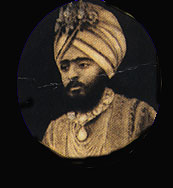
In
1906 Tikka Ripudaman Singh (above) was appointed as additional member to the Imperial
Legislative Council in Calcutta for a two-year term. During this period he joined
hands with nationalist leaders such as Gopal Krishna Gokhale and Madan Mohan Malaviya
in their opposition to restrictive legislation such as the Press Act of the Government
of India. He also introduced the Anand Marriage Bill sought to legitimize Sikh
marriages conducted according to their simple religious rites known as anand.
His interest in social reform was further evidenced when he presided over the
Indian National Social Conference held at Lahore in 1909. In 1910, he went abroad
for medical treatment. He attended the coronation of King George V at Westminster
on 22 June 1911. He was in France when the news reached him of his father's death
on 25 December 1911.
He came back to India, and ascended the throne of Nabha
on 24 January 1912. A man of independent views, the Maharaja alienated the British
at the very outset by contesting their right to confirm his succession to the
throne with a formal investiture of a 'khillat' (robe of honour). Maharaja, citing
a precedent of an installation ceremony in 1863, wanted only the necklace to be
placed on him. Although the matter was amicably settled and the ceremony did take
place on 20 December 1912, and later during the Great War (1914-1918), the Maharaja
liberally contributed to the British war effort, the British always looked askance
at him. His overt support to the Gurdwara Reform movement in the Punjab led to
further alienation. Meanwhile, an acrimonious dispute had arisen between Maharaja
Ripudaman Singh and the ruler of the neighbouring state of Patiala, Maharaja Bhupinder
Singh. Among the welter of charges and countercharges, Patiala accused Nabha of
the kidnapping of officials and other violations of Patiala's sovereignty, while
Nabha sought the extradition of a woman allegedly employed by Patiala's secret
police but accused of theft in Nabha. After efforts at conciliation between the
two rulers had proved futile, the British launched an enquiry by one of their
own officers who found Nabha guilty of serious transgressions. Even some of Maharaja
Ripudaman Singh's own former confidants had deposed against him.
Partly under
British pressure and partly persuaded by one of his former officers, Captain O'Grady,
he signed a letter of voluntary abdication on 7 July 1923, and the British government
formally deposed him on 9 July 1923. He was sent to Dehra Dun on an annual pension
of Rs 300,000. His son, Prince Pratap Singh, born on 22 September 1919 of his
second marriage in 1918 to Sarojini Devi, daughter of Major Prem Sirigh Garewal,
of the Hyderabad State Army, was proclaimed ruler of Nabha and the state was placed
under a British administrator during theprince's minority.
The Maharaja's deposition
and expulsion from Nabha led to strong popular protest. In a series of demonstrations
and meetings people demanded the restoration of the Maharaja. The protest soon
took the form of a religious movement which came to be known as Jaito
morcha. The morcha or agitation was led by
the Shiromani Gurdwara Parbandhak Committee.
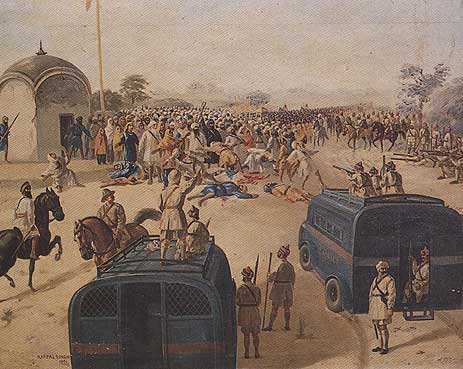
Massacre at Jaito {As protest against the intrruption of Akhand Path during the Nabha Agitation, batches of 500 Singhs proceeded daily towards Jaito. On February 21, 1924 the police opened fire on the group, killing 20 Singhs on the spot and wounding more than one hundered. Nabha Agitation exercised such an impact on the public that even Jawahar lal Nehru accompanied by Shri Satnam and Gidwani courted imprisonment.
It became intensified after the state authorities had interrupted an akhand path, continued reading of Guru Granth Sahib, the Sikh Scripture, at Gurdwara Gang Sar at Jaito, a small market-town. The agitation, while successful in winning freedom of worship in gurdwdrds, failed in its political aim, i.e. the restoration of the Maharaja to his throne. He was instead removed in 1926 from Dehra Dun to Kodalkanal, in the far South. Two years later his pension was reduced to Rs 1,20,000, per annum, and many other concessions were withdrawn. His efforts to regain his gaddi through lobbying with some prominent nationalist leaders, lawyers and journalists proved abortive. But he remained unbent and unrepentant. Early in 1927 he went on pilgrimage to Sri Abichalnagar Hazur Sahib, Nanded, where he took the Khalsa pahul (initiation rites) a second time and was renamed Gurcharan Siiigh. He died at Kodalkanal on 13 December 1942.
Text courtesy Encyclopaedia Sikhism by Harbans Singh
NABHA (Princely State)
(13 gun salute)
AREA: 2,453 km2
PRIVY PURSE: 410,000R ACCESSION: 20th August 1948
STATE: Pepsu DYNASTY: Phulkian
RELIGION: Sikh
PRESENT RULER: HH Maharaja HANUWANT SINGH Malvinder Bahadur, 9th Maharaja of Nabha (1995/-)(Hira Mahal, Nabha - 147201, Punjab, India) married Maharajkumari Deergh Kaur of Bharatpur, and has issue, 2 sons who are married to the grand-daughters of the Thakur of Wadhwan.
PREDECESSORS
AND SHORT HISTORY: Claiming descent from Jaisal, founder of the State of Jaisalmer
in 1156, the founder of this Sikh dynasty, Phul, was Chaudhri (Governor) of a
country located at the south east of Dihli. Phul's descendants founded 3 States:
Patiala, Jind and Nabha. Nabha was founded by the great-grandson of Phul in 1755.
Rulers were..
1. Raja HAMIR SINGH 1755/1783 (son of Suratya Singh), married
and had issue. He died December 1783.
· Raja JASWANT SINGH (qv)
·
Bibi Sada Kaur, married Sardar Jai Singh Kanhaiya 1712-1793
2. Raja JASWANT
SINGH 1783/1840, born 1775, married and had issue. He died 22nd May 1840.
·
Rajkumar Ranjit Singh, married and had issue. He died 17th June 1832.
·
Kanwar Santokh Singh, died 1830.
· Raja DEVENDRA SINGH (qv)
3.
Raja DEVENDRA SINGH 1840/1846 (deposed), born 1822, married and had issue. He
died November 1865 at Lahore.
· Raja BHARPUR SINGH (qv)
·
Raja BHAGWAN SINGH (qv)
4. Raja BHARPUR SINGH 1846/1863, born 1840, died sp
9th November 1863.
5. Raja BHAGWAN SINGH 1863/1871, born 1842, died sp 1871.
6. HH Raja Sir HIRA SINGH Malvinder Bahadur 1871/1911, born 19th December
1843, son of Sardar Sukkha Singh of Badrukhan, installed on the gaddi of Nabha
state on 10th August 1877, granted the titles of Raja-i-Rajgan and Maharaja, provided
funds for the establishment of the Khalsa Printing Press at Lahore, supported
the Khalsa College at Amritsar and promoted the reformist (Anand) form of Sikh
marriage, married Rani Jasmaer Kaur, daughter of Sardar Anokh Singh Longowalia,
and had issue. He died 25th December 1911 at Nabha.
· HH Maharaja RIPUDAMAN
SINGH Malvinder Bahadur (qv)
· Daughter, married HH Maharajah Rana
RAM SINGH of Dholpur.
7. HH Maharaja RIPUDAMAN SINGH Malvinder Bahadur 1911/1928
(deposed), granted a local salute of 15 guns in 1921, deprived of the title Maharaja
in 1928, born 4th March 1883 in Nabha, married 1stly, HH Maharani Bibi Jagdhish
Kaur, daughter of Sardar Gur Dayal Singh Mann, married 2ndly, 10th October 1918,
HH Maharani Sarojan Devi, daughter of Sardar Prem Singh Raipuria, and had issue.
He died 24th January 1943 in Kodaikanal.
· HH Maharaja PRATAP SINGH
Malvinder Bahadur (qv)
· Rani Bibi Amrit Kaur, born 8th October 1907,
married 16th February 1925, Raja RAVI SHER SINGH Sahib Bahadur of Kalsia, and
had issue.
8. HH Maharaja PRATAP SINGH Malvinder Bahadur 1928/1995, born 21st
September 1919, K.S.C.I. [cr.1946], G.S.C.I. [cr.1933], married 25th April 1944,
HH Maharani Urmilla Devi of Dholpur and had issue. He died 1995.
·
HH Maharaja HANUWANT SINGH Malvinder Bahadur (qv)
· HH Maharaja Rana
HEMANT SINGH, 6th Maharaja Rana of Dholpur (qv)
9. HH Maharaja HANUWANT SINGH
Malvinder Bahadur (son) (see above)
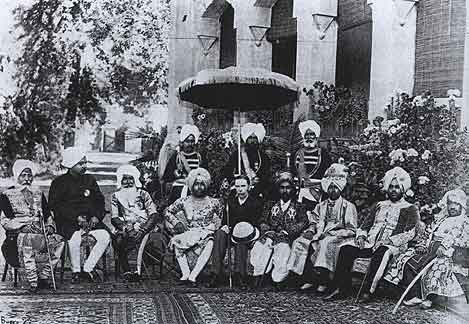
A group of Maharajas with a British emmisary. Maharaja Hira Singh can be seen third from left and Maharaja Jagatjit Singh second from right.
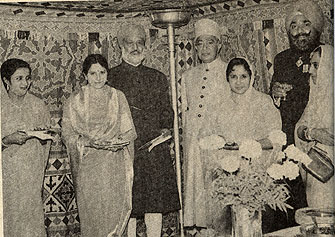
The Maharaja of Nabha (extreme right) with members of other Royal families. S. Ardaman Singh Bagrian is seen third from left